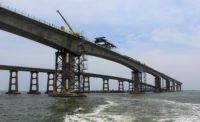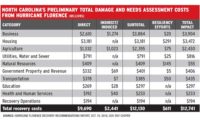Flood Gauges Track Hurricane Florence's Historic Trendline

Hurricane Florence’s rains set many records across both of the Carolinas.
PHOTO: COURTESY OF DUKE ENERGY
According to a new analysis, U.S. Geological Survey stream gauges in the Carolinas recorded many instances of record-setting water levels during Hurricane Florence in September, with the majority of those eclipsing previous historic peaks set just two years prior during Hurricane Matthew.
Scientists reviewed 485 USGS stream gauges in the Carolinas and focused on 84 that have registered data for at least a decade—with some sites in continuous operation for more than 70 years.
Among those, Hurricane Florence water levels were among the top five ever measured at those sites, with records set at 28 of them. Of those 28, flooding recorded after Hurricane Matthew in October 2016 was the second-largest peak at 11 of them and Hurricane Floyd’s flooding in 1999 was the second-largest peak at four others.
The 28 USGS stream gauges detecting new record flood levels were widely dispersed as well, including locations as far west as Greensboro, N.C.
Hurricane Florence also was one of the nation’s rainiest storms in the last 70 years, with four-day rainfall totals averaging 17.5 in. over an area of 14,000 sq miles, according to preliminary research by the North Carolina Institute of Climate Studies. Although the highest rainfall totals were recorded near the coast where the storm lingered for several days, new precipitation records were set across both North and South Carolina.
In addition, the USGS analysis found that 49 stream gauges recorded new peak flows following Hurricane Florence that ranked in the top five for their respective recording periods. Florence-related flooding ranked in the top five at 20 gauge locations with at least 30 years of recorded data.
Toby Feaster, USGS hydrologist and lead author of the study, noted in an agency-issued statement that given the availability of data from several gauges with more than 30 years of historical data, “it was interesting that a majority of the number one and two records were from back-to-back flooding events.” The USGS study notes, however, that the short interval between historic floods, while rare, is not unprecedented. It cites a gauge on the Congaree River at Columbia, S.C., where the second- and third-largest floods were recorded in August 1928 and October 1929. Both events were related to tropical storm systems.




